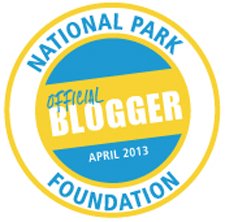Yosemites Covered Bridge...
How It Was Saved From Destruction

Some Background
Yosemites Covered Bridge in Wawona was the subject of the November 1957 issue of Yosemite Nature Notes.
The bridge was nearing collapse, and the question at the time was…“can it be saved?”
The natural follow up to that question back in the ‘50’s was “should we bother?”
It was decided that it was worth a try.
For
nearly 40 years Yosemite Nature Notes served the park and the National
Park interpretive program. First mimeographed as a newsletter in July
10, 1922 “Nature Notes” evolved into a small booklet containing
interesting Yosemite themed articles and was produced monthly.
The little publication was read in its various forms through the years by millions of park devotees.
In its more than 400 regular issues and 23 special issues can be found much of the story of Yosemite National Park-its human history, archaeology, biology and geology.
Revenues from Yosemite Nature Notes were dedicated entirely to assisting the park naturalist division in the furtherance of research and interpretation of the natural and human story in Yosemite National Park.
The article entitled “Saving The Wawona Covered Bridge” by Ranger Naturalist Jack Fry appears here in its’ entirety:
The Bridge In Collapse
To Ranger Naturalist Arthur G. Remple's question, "Can the Wawona Covered Bridge Be Saved?" (Yosemite Nature Notes 35:3, 1956) we can give two answers, yes, and no.
We say no, because the original bridge that was built sometime before 1874, has been dismantled. On the other hand, we can answer in the affirmative, for the bridge has been restored, using many of the same materials which were part of the original structure.

The old covered bridge, which had for many winters withstood the battering and hammering of the high waters of the South Fork of the Merced River, was mortally wounded during the floods of the 1955 winter.

The rotted timbers were no longer able to stand up against the swirling waters of the river at flood stage. A temporary wooden pier was placed under one end of the bridge to prevent it's total collapse which seemed apt to occur at any time. One thing was very evident - the bridge could not survive another winter. Something had to be done.
A bridge at this location is necessary, not only for pedestrians and equestrians, the principal users of the bridge since realignment of the Wawona Road took place in 1931, but for limited vehicular traffic in the event that the main bridge was damaged or washed out by a future flood.
The question, then, was should the covered bridge be restored or should a modern type bridge be constructed in its place.
Three types of replacement bridges were suggested: (1) an all-concrete bridge; (2) a steel beam bridge with a concrete deck; (3) a wood beam bridge with a laminated wood deck.
Any bridge constructed here would have to have a center span which would be long enough to allow for the passage of long uprooted trees and other debris during a flood. The deck and it's supporting structures would have to be completely above the level reached by the South Fork at flood stage, and the clear width of the deck would have to be at least ten feet.
A Variety Of Important Considerations
There were many reasons for considering the restoration of the old bridge. One was it's historical significance to the Wawona area and Yosemite National Park. In addition, it was one of the last survivors of the many covered bridges which were constructed in California.
Another consideration was that the Wawona Covered Bridge was the only one of it's kind in a western National Park Service area and possibly the only covered bridge in the entire National Park System.

Finally, it was felt that it's presence would contribute a great deal to the Wawona Pioneer Village which will be constructed under the National Park Service MISSION 66 program.
The Village will utilize the old wagon shop to house historic vehicles and the Hodgdon Homestead Cabin, which will be furnished and equipped as it may have been at the time it was built. In fact, the bridge restoration itself was a MISSION 66 project and was considered one of the first steps in the development of the pioneer village.
How The Old Bridge Was Built
Before describing the restoration process, it might be of interest to examine the basic plan of the bridge. The bridge consisted of two parallel wooden trusses 14 feet apart. Each of these had an overall length of 130 feet and a clear span of 106 feet.

Each was composed of an upper chord, a lower chord, two diagonal chords and 7 perpendicular panel points. These timbers were all hand hewn and varied in sizes from 12x14 inches to 14x 18 inches, the lower chords being of the latter size. The stringers which ran the length of the bridge parallel to and between the lower chords were 12x16 inches, and the transverse floor beams, which ran perpendicular to the lower chords, were 12x14 inches.
The latter were also hand hewn. For the most part, the remaining member and the housing materials were mill-sawed timber. The housing was 130 feet long and 26 feet high (to the top of the gable roof). The opening at each end was 14'2" high and 14'2 1/2” wide.
The Restoration, And How They Did It

Following the high water of the 1955 winter season, the bridge was examined by Mr. F. P. Cordero, Field Engineer of California Division of Highways, and in his report of July 5, 1956, he described the condition of the bridge.
The lower chords of both upstream and downstream trusses had failed due to rot. Failure of the lower chord on the downstream side had caused the bridge to sag some 3 to 4 feet; practically all panel points of both trusses were distorted.
The upstream ends of two of the floor beams were broken by the drift during the 1955 high water, and all floorbeams showed evidence of decay.

Cordero went on to state that the entire structure was in such poor physical condition that it was in danger of collapsing from it's own dead weight at any time.
The first and most urgent step was to pull the bridge over to the north bank before the flood season began. To do this, it was jacked up and a cribbing built of wooden beams placed beneath it. Pieces of 3-inch pipe were placed between wooden tracks and the lower chords to serve as rollers. Blocks and cables were rigged and the winch on a caterpillar tractor pulled the old bridge to safety on November 29, 1956.

After careful measurements had been taken, the bridge was dismantled. All rotted timbers and materials were discarded and all salvageable wood was carefully saved. To facilitate the removal of the shingles, about 14 bundles of 20% dynamite were strung beneath the roof, then detonated. The blast removed the shingles neatly and loosened the nails so that they could be pulled out easily.
New abutments were constructed in the same places that the old ones had stood. These new abutments, unlike the former ones, which were made of hewn wooden cribbing with rock fill, were made of reinforced concrete which will be covered by rock rubble.
The reconstruction of the bridge took place on the north bank of the river.
The New Timbers Were Hand-Hewn

New timbers were hand hewn from ponderosa pine and the trusses were assembled on steel "I" beams (steel beams whose cross-section resembles the letter "I"), which were to serve as "tracks" when the bridge was pulled back into place. To guard against water, all joints were made watertight so that moisture could not invade them and provide a suitable habitat for fungi which would cause rotting, one of the major factors contributing to the weakening of the old bridge. Paper and sealing material were placed between all timbers. This plus the weight of the timbers produced a watertight seal.
The Covered Bridge Takes Shape

Slowly, yet steadily, the Wawona Covered Bridge began to rise again. Mr. Glen Gordo, under whose immediate supervision the restoration was carried out, is to be complimented for his efforts to insure that the completed bridge would be exactly like the former structure in every detail - even to the point of using square nails which are like those found in the former bridge.
The restored bridge is sound enough that many of the members could have been omitted, but they have been included in the structure for authenticity - because they were in the old bridge.

When all of the work had been completed (with the exception of siding, flooring and shingles), the bridge was pulled back into place. Steel "I" beams were placed across the two permanent and two temporary abutments, level with the "I" beams on which the bridge was resting. These were then welded together forming one continuous "track". The bridge was then raised and three inch pipe was placed between the lower chords and the track so that the restored bridge could be pulled back into place just as the old bridge had been pulled to safety.
After the bridge had been pulled back into position, an operation which lasted about 5 hours, it was once more jacked up, the pipe and "I" beams were removed, and it was lowered onto its abutments, never, it is hoped, to be moved again.
Linking Back To Yosemite's Past

Now with the siding, flooring, and shingles in place, the Wawona Covered Bridge stands again. It stands solidly, with no temporary piers to help support it.
It stands true with no sag or lean. Now today's children and after them their children, can see an authentic covered bridge. Children who are familiar with six-lane highways, high speed automobiles, complex "clover-leaves," and mighty steel bridges can see, touch, and walk through the covered bridge that grandmother rode through on her way to Yosemite Valley.
Another link with Yosemite's colorful and wonderful past has been saved.
To return to the Home Page from Yosemites Covered Bridge page click here.
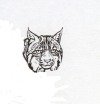
Yosemite's Old West
Cavalry In Yosemite
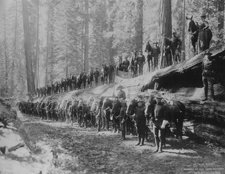
Yosemite's First Rangers, The US Army.
Yosemite...Camping And Hiking In Wawona
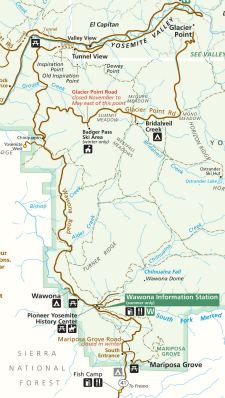
Yosemite Camping And Hiking In Wawona
Yosemite "Stagecoach Stories"...Book And Kindle eBook
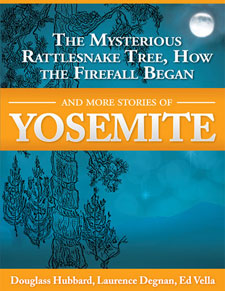
Historic Wawona








